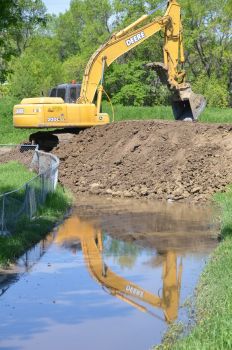Contractor Quality Control

|
| USACE contractor oversees the construction of a dike.
(Image Source: Wikimedia) |
Contractor Quality Control (CQC) for dams is the processes implemented by contractors working on dam construction or maintenance projects that ensures that work on a project meets the specified quality standards. CQC is a crucial aspect of dam projects as it helps to ensure the structural integrity, safety, and long-term performance of the dam.
Contractor Quality Control programs typically involve the following key components:
1. Quality Management Plan: The contractor develops a comprehensive Quality Management Plan (QMP) that outlines the strategies, methodologies, and responsibilities for achieving and maintaining quality during the entire project. The QMP establishes quality objectives, defines quality control procedures, and identifies the individuals responsible for implementing and monitoring quality control measures.
2. Inspection and Testing: The contractor conducts regular inspections and testing to verify compliance with the dam’s design specifications, applicable regulatory requirements, and current industry standards. This step stresses the importance of inspecting materials, construction techniques, equipment, and completed work. Various testing methods such as laboratory testing of materials, non-destructive testing, and field testing are employed to assess the quality of construction.
3. Documentation and Records: Throughout the construction process, the contractor maintains detailed documentation and records of all quality control activities, including inspection reports, test results, and certifications. These records serve as key evidence of compliance with quality requirements.
Best Practices Resources
![]() A Guide to Effective Contractor Quality Control (CQC) (EP 715-1-2), USACE
A Guide to Effective Contractor Quality Control (CQC) (EP 715-1-2), USACE
